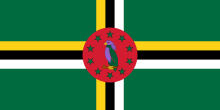DOMINICA
 Dominica’s area is 750 sq km. The island has the highest mountains in the Eastern Caribbean. There are seven volcanoes in activity in Dominica, it is one of the largest concentration of volcanoes in the world. The highest point is the Morne Diablotin with its 1427m (4747ft). « Morne Trois Gros Pitons National park” is listed as a UNESCO World Heritage Site, since December, 1997. With regard to the rivers, they are over 200. Its fauna is very rich. More than 160 species of bird live in the island. The Sisserou (Amazona Imperialis) or imperial parrot is the national bird : it is the largest of all Amazon parrots with its 50cm long. There are also the big toad or endemic crapaud to Dominica and Montserrat (that serve to prepare the national dish called chicken mountain), 55 species of butterfly or boas which can be 3m long.
Dominica’s area is 750 sq km. The island has the highest mountains in the Eastern Caribbean. There are seven volcanoes in activity in Dominica, it is one of the largest concentration of volcanoes in the world. The highest point is the Morne Diablotin with its 1427m (4747ft). « Morne Trois Gros Pitons National park” is listed as a UNESCO World Heritage Site, since December, 1997. With regard to the rivers, they are over 200. Its fauna is very rich. More than 160 species of bird live in the island. The Sisserou (Amazona Imperialis) or imperial parrot is the national bird : it is the largest of all Amazon parrots with its 50cm long. There are also the big toad or endemic crapaud to Dominica and Montserrat (that serve to prepare the national dish called chicken mountain), 55 species of butterfly or boas which can be 3m long.
Its flora is also rich. The gum trees are very numerous and traditionaly used to make canoes. Dominica is nickmaned “Island of Nature”.
On the economic field, after it was the first bananas supplier in tthe British market in the 1980s, in 1992, Dominica lost its preferential access and the income that was generated by this exportation fell. Today, agriculture (bananas, coprah, coconuts, citrus fruits) represents an important part in the dominican economy but the government invests a lot of money in tourism development, in particular, in ecotourism.
The first Carib Indians who settled in this land, in the 14th century, named it “Waitikubuli”, that means “Tall is Her Body”. On Sunday November 3, 1493, when Christopher Columbus saw this island, he named it after the day of the week : Sunday is Doménica in Italian. Because the Amerindians were very tenacious and there was no gold mine so, the Spanish were discouraged and they left Dominica.
In 1635, France appropriated the island. The first French missionaries were chased out by the Caribs too. In 1660, French and English signed an agreement to let the island to the Amerindians. But, by the end of the 17th century, French settlers who came from French Antilles colonies developed farms in Dominica. In the 1720s, the French monarchy appointed there a governor. During the 18th century, France and Great Britain fought to conquer Dominica and the island changed nationality several times. After the Seven Year’s War and the Treaty of Paris in 1763, the French gave up the island to the English with regret but they tried to appropriate it again in 1795 and 1805. Roseau, the capital, burnt completely, during this last war. From this year, Dominica stayed a British colony and developed the growing of sugar cane. In 1814, it became officially British and, in 1898, it gained the British colony status.
In 1903, after centuries of conflicts with the European colonists, the Carib people gained from the British government a 1497 ha-territory on the north-east coast of Dominica. 3500 Carib Indians have been settled there with their chief. It is the only one reservation of Carib Indians in the West Indies. Today, these Amerindians who are, for example, farmers, fishermen, hotel-keeper, artisans, are perfectly integrated into the Dominican society.
From 1967, the island became more autonomous and, on November 3, 1978, for the 485th anniversary of its “discovery” by Columbus, Dominica became an independent state which is led by a Primer Minister. It belongs to the Commonwealth.
Area : 750 sq km (289,5 sq miles)
Population : 73 600 inhabitants
Capital : Roseau
Languages : English (official) – Kokoy – Creole
Currency : Eastern Caribbean Dollar (EC$)
People : Dominicans
